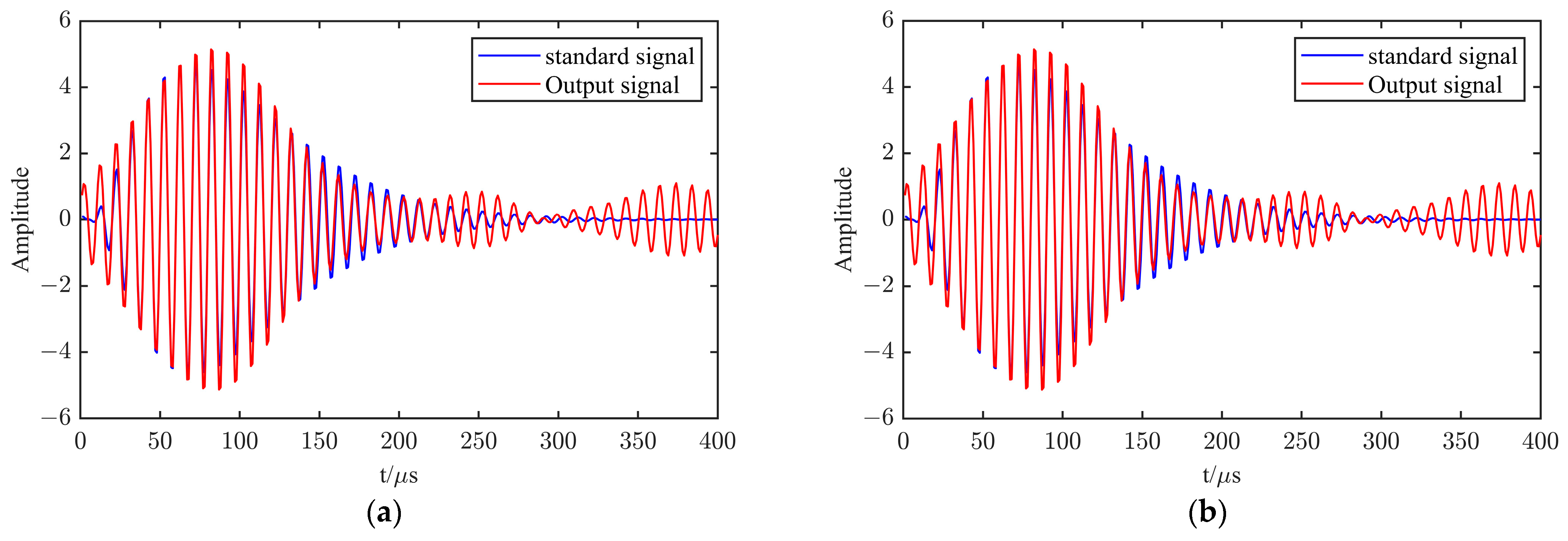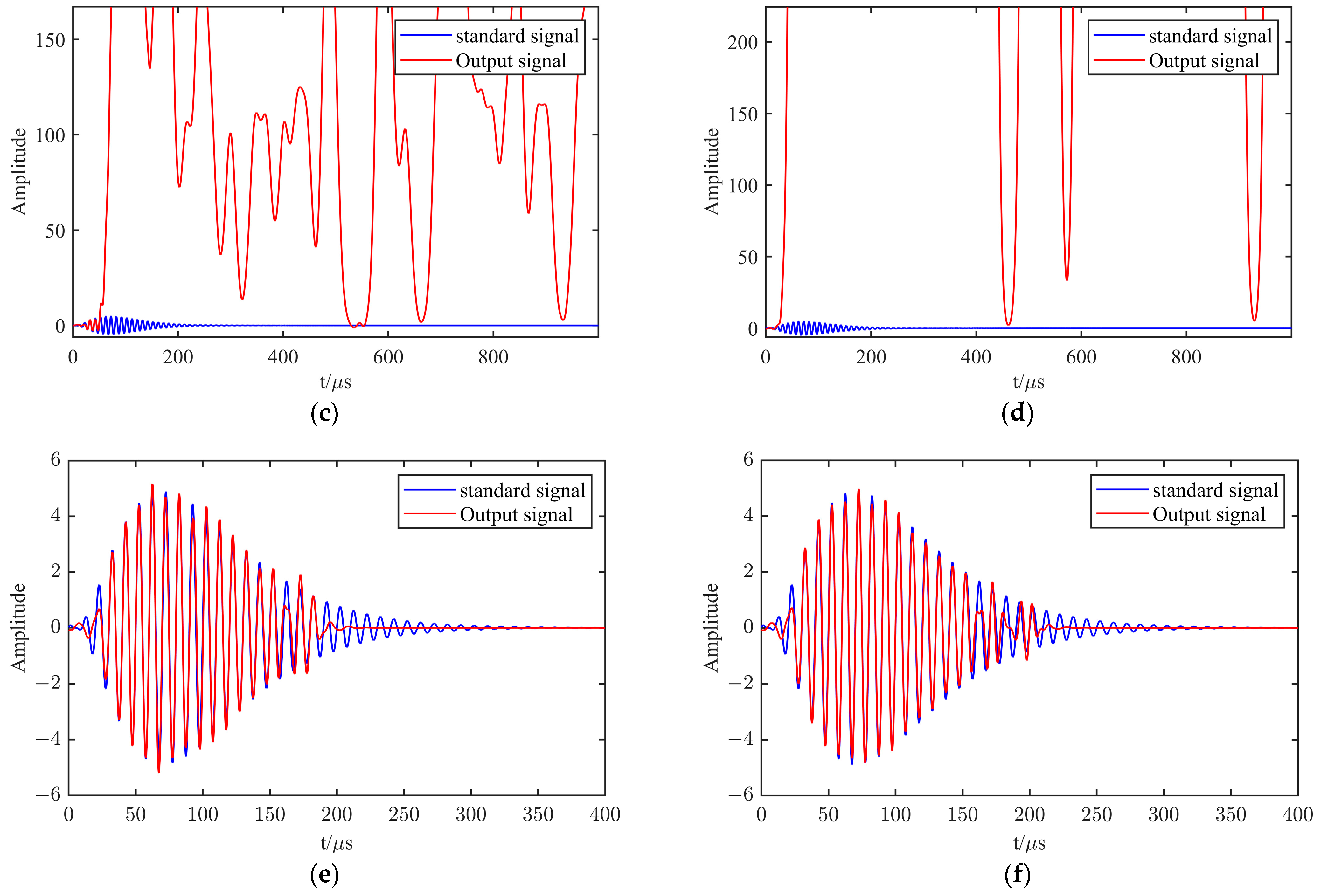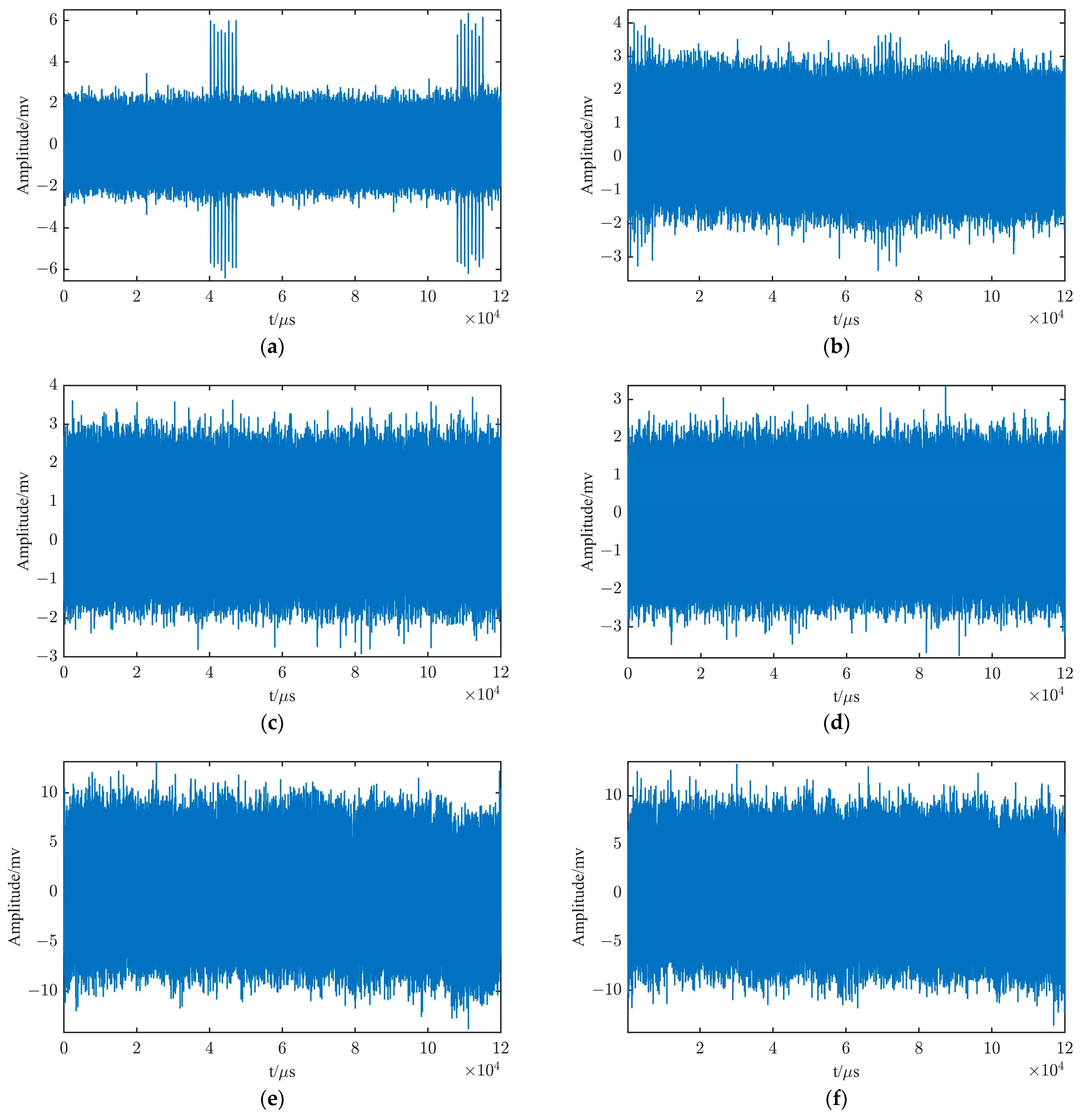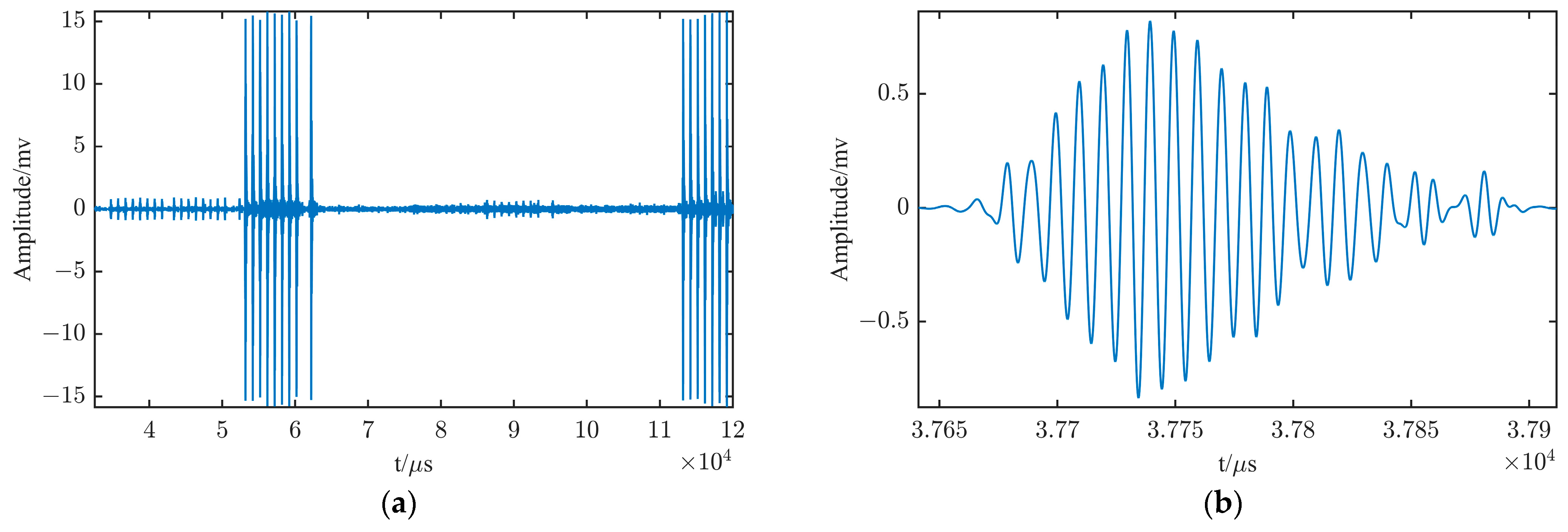Research on eLoran Weak Signal Extraction Based on Wavelet Hard Thresholding Processing
Abstract
:1. Introduction
2. Materials and Methods
2.1. eLoran Signal Characteristics
eLoran Signal Format and Waveform
2.2. Research on eLoran Weak Signal Extraction Method Based on IIR Filters
Introduction to IIR Filters and the Filter Used in This Article
2.3. Research on an Improved Method Based on Wavelet Hard Thresholding Processing
2.3.1. Wavelet Transform and Wavelet Hard Thresholding
2.3.2. Improved Methods
3. Results and Discussion
3.1. Analysis of IIR Filter Simulation Results
3.2. Simulation Results Analysis of Wavelet Hard Thresholding Processing and Improved Methods
3.2.1. Analysis of Simulation Results of Hard Thresholding under Different Conditions
- Analysis of simulation results of hard thresholding under different wavelet bases
- Analysis of simulation results of wavelet hard thresholding under different sampling rates
- Analysis of simulation results of wavelet hard thresholding under different decomposition layers
3.2.2. Analysis of the Simulation Results of Wavelet Hard Thresholding and the Improved Method under Suitable Parameters
- Analysis of simulation results of wavelet hard thresholding under suitable parameters
- Analysis of simulation results of the improved method with suitable parameters
3.2.3. Comparative Analysis of the Three Methods
3.3. Final Simulation and Analysis of Three Methods
3.4. Analogue Source Signal and Actual Signal Test Analysis
3.4.1. Analogue Source Signal Test Analysis
3.4.2. Actual Signal Test Analysis
4. Conclusions
- (1)
- The IIR filter is not able to remove the noise present in the frequency band where the eLoran signal is located when extracting the weak eLoran signal. Noise peaks of various frequencies exist in the frequency band. As the input signal-to-noise ratio decreases, the effect of in-band noise intensifies. The extracted eLoran signal waveform will be distorted. The peak value shows a significant delay. Phase accuracy also decreases with the reduction of the signal-to-noise ratio. Although this method is significantly affected by white noise, it can effectively suppress atmospheric noise caused by lightning.
- (2)
- When wavelet hard thresholding is used to extract the weak eLoran signal, the sampling rate should be 20 MHz, the number of decomposition layers should be chosen from 7 to 9, and the Dmeyer wavelet basis should be chosen. In the simulation of this condition, the wavelet hard thresholding process removes the noise in the frequency band well. Only the main peak of the eLoran signal exists in the frequency band. The out-of-band noise amplitude is very small, much smaller than the in-band signal amplitude. This method obtains a high signal-to-noise ratio for eLoran signals, and suffers from the problems of tailing disappearance and the difficulty of removal of some noises with high coefficients. As the noise increases, more of the output signal’s tail disappears. In addition, this method cannot suppress the noise caused by lightning, making it unable to extract the eLoran signal under conditions of high lightning-induced noise.
- (3)
- The output signal-to-noise ratio of the improved method is much higher than the result of the conventional IIR filter, and is also better than the wavelet hard thresholding process overall. It can solve the problem of in-band noise while suppressing out-of-band noise, and the overall waveform is much better than the output of traditional IIR filters. At the same time, it basically eliminates some of the noise with large coefficients and retains more of the waveform tailing. The phase accuracy is high, and it can simultaneously suppress both Gaussian white noise and noise caused by lightning. It is a good eLoran weak signal extraction method.
- (4)
- In the test of analogue source signals, the characteristics of the three methods agree with the simulation. Among them, the improved method has better results and can intactly extract eLoran signals with levels above 30 dBμV/m.
- (5)
- In real signal testing, wavelet hard thresholding cannot extract the eLoran signal. IIR filter can extract the eLoran signal, but the waveform is severely distorted. The improved method can extract the eLoran signal and the waveform is only partially distorted. Based on the results, the input signal-to-noise ratio can be estimated to be −28.8 dB, which is an extremely low signal-to-noise ratio. This shows that the method is a suitable and effective eLoran weak signal extraction method, which provides a strong guarantee for signal monitoring in the border area of eLoran signal coverage.
Author Contributions
Funding
Data Availability Statement
Acknowledgments
Conflicts of Interest
References
- Zhang, H.; Xu, B.; Li, H.; Liao, D.; Chen, H. Prospects for Development of LORAN-C Navigation System for Building up National Comprehensive PNT System. J. Astronaut. Metrol. Meas. 2020, 40, 6–11. [Google Scholar]
- Chen, Y. Research of eLoran Time Service Monitoring Evaluation Method and System Design. Ph.D. Thesis, University of Chinese Academy of Sciences, Beijing, China, 2022. [Google Scholar] [CrossRef]
- International Loran Association. Enhanced Loran (eLORAN) Definition Document; 2007; Available online: https://rntfnd.org/wp-content/uploads/eLoran-Definition-Document-0-1-Released.pdf (accessed on 16 July 2024).
- Xu, Z.; Wu, Y.; Zhang, L.; Li, Y. Adaptive Fourier Decomposition Based Signal Extraction on Weak Electromagnetic Field. In Proceedings of the ICASSP 2024—2024 IEEE International Conference on Acoustics, Speech and Signal Processing (ICASSP), Seoul, Republic of Korea, 14–19 April 2024; IEEE: Piscataway, NJ, USA, 2024; pp. 9446–9450. [Google Scholar]
- Kalman, R.E. A New Approach to Linear Filtering and Prediction Problems. J. Basic Eng. 1960, 82D, 35–45. [Google Scholar] [CrossRef]
- Zhao, X.; Wang, L.; Chen, Z.; Shao, P.; Chen, R. Weak Signal Detection Method Based on Bayesian Neural Network. In Proceedings of the 2023 IEEE 6th International Conference on Pattern Recognition and Artificial Intelligence (PRAI), Haikou, China, 18–20 August 2023; IEEE: Piscataway, NJ, USA, 2023; pp. 816–822. [Google Scholar]
- Wang, Y.; Huang, H. Research on Chemical Weak Signal Detection Based on Stochastic Resonance Algorithm. In Proceedings of the 2023 International Conference on Power, Electrical Engineering, Electronics and Control (PEEEC), Athens, Greece, 25–27 September 2023; IEEE: Piscataway, NJ, USA, 2023; pp. 754–759. [Google Scholar] [CrossRef]
- Weili, T. Research on Signal Process in the Front of Loran-C Receiver. Master’s Thesis, Xidian University, Xi’an, China, 2007. [Google Scholar]
- Yanwei, S. Study on Key Technologies of eLoran Signal Processing. Master’s Thesis, Harbin Engineering University, Harbin, China, 2019. [Google Scholar]
- Zeng, T.; Hua, Y.; Wang, X.; Yan, W. Research on Pretreatment Method of eLORAN Received Signal Based on Spectral Subtraction. In Proceedings of the 2019 IEEE 4th Advanced Information Technology, Electronic and Automation Control Conference (IAEAC), Chengdu, China, 20–22 December 2019; IEEE: Piscataway, NJ, USA, 2019; pp. 605–612. [Google Scholar]
- Jie, W.; Rui, L. Introduction to Long-Range Land-Based Radio Navigation Systems, 1st ed.; Science Press: Beijing, China, 2017; pp. 95–104. [Google Scholar]
- Ruikun, Z. FIR and IIR Digital Filter Designing Based on MATLAB. Master’s Thesis, Jilin University, Changchun, China, 2012. [Google Scholar]
- Proakis, J.G.; Manolakis, D.G. Digital Signal Processing Principles, Algorithms, and Applications, 4th ed.; Publishing House of Electronics Industry: Beijing, China, 2014; pp. 481–540. [Google Scholar]
- Gupta, V.; Mahle, R.; Shriwas, R.S. Image Denoising Using Wavelet Transform Method. In Proceedings of the 2013 Tenth International Conference on Wireless and Optical Communications Networks (WOCN), Bhopal, India, 26–28 July 2013; IEEE: Piscataway, NJ, USA, 2013; pp. 1–4. [Google Scholar]
- Dong, X. Extracting Characteristic Information of Weak Signal from Strong Noise Background by Wavelet Analysis. Master’s Thesis, Wuhan University, Wuhan, China, 2003. [Google Scholar]
- Yang, G.; Song, Y.; Du, J. Speech Signal Denoising Algorithm and Simulation Based on Wavelet Threshold. In Proceedings of the 2022 4th International Conference on Natural Language Processing (ICNLP), Xi’an, China, 25–27 March 2022; IEEE: Piscataway, NJ, USA, 2022; pp. 304–309. [Google Scholar]
- Xin, L. Research on Weak Signal Extraction in a Strong Noise Environment Based on Wavelet Analysis. Master’s Thesis, Nanjing University, Nanjing, China, 2012. [Google Scholar]
- Donoho, D.L. De-Noising by Soft-Thresholding. IEEE Trans. Inf. Theory 1995, 41, 613–627. [Google Scholar] [CrossRef]
- Nie, X. Research on Extraction and Application of Weak Signals Based on Wavelet Transform. Master’s Thesis, Beijing University of Civil Engineering and Architecture, Beijing, China, 2015. [Google Scholar]
- Gan, Z.; Xu, X.; Qiu, Y.; Xie, T.; Chang, Y.; Wu, X.; Zhao, R. Application of Improved Wavelet Threshold Denoising Method in Power Quality Signals with Noise. In Proceedings of the 2023 4th International Conference on Advanced Electrical and Energy Systems (AEES), Shanghai, China, 1–3 December 2023; IEEE: Piscataway, NJ, USA, 2023; pp. 156–160. [Google Scholar] [CrossRef]
- Fu, R.; Zhang, J.; Wang, R.; Xu, T. Improved Wavelet Thresholding Function and Adaptive Thresholding for Noise Reduction. In Proceedings of the 2023 11th International Conference on Intelligent Computing and Wireless Optical Communications (ICWOC), Chongqing, China, 16–18 June 2023; IEEE: Piscataway, NJ, USA, 2023; pp. 25–30. [Google Scholar]
- ITU-R P.372-16; Radio Noise. ITU: Geneva, Switzerland, 2022.
- Varlamov, V.O.; Waal, A.; Varlamov, O.V. Maximum Levels of Atmospheric Radio Noise Affecting Digital Radio Broadcasting in the LF and MF Bands in Various Regions. In Proceedings of the 2023 International Conference on Engineering Management of Communication and Technology (EMCTECH), Vienna, Austria, 16–18 October 2023; IEEE: Piscataway, NJ, USA, 2023; pp. 1–6. [Google Scholar] [CrossRef]
- ITU-R P.368-10; Ground-Wave Propagation Prediction Method for Frequencies between 10 kHz and 30 MHz. ITU: Geneva, Switzerland, 2022.
- Liu, X.; Hu, A. Research on Application Extension of Long Wave Navigation System. China Acad. J. Electron. Publ. House 2013, 4, 116–119. [Google Scholar]



























| Input SNR | IIR Filter | Wavelet Hard Thresholding | Improved Method |
|---|---|---|---|
| 0 dB | 12.7 dB | 21.3 dB | 23.4 dB |
| −5 dB | 10.1 dB | 15.8 dB | 18.5 dB |
| −7 dB | 6.4 dB | 14.5 dB | 16.0 dB |
| −10 dB | 5.1 dB | 12.6 dB | 14.8 dB |
Disclaimer/Publisher’s Note: The statements, opinions and data contained in all publications are solely those of the individual author(s) and contributor(s) and not of MDPI and/or the editor(s). MDPI and/or the editor(s) disclaim responsibility for any injury to people or property resulting from any ideas, methods, instructions or products referred to in the content. |
© 2024 by the authors. Licensee MDPI, Basel, Switzerland. This article is an open access article distributed under the terms and conditions of the Creative Commons Attribution (CC BY) license (https://creativecommons.org/licenses/by/4.0/).
Share and Cite
Cheng, L.; Zhang, S.; Qi, Z.; Wang, X.; Chen, Y.; Feng, P. Research on eLoran Weak Signal Extraction Based on Wavelet Hard Thresholding Processing. Remote Sens. 2024, 16, 3012. https://doi.org/10.3390/rs16163012
Cheng L, Zhang S, Qi Z, Wang X, Chen Y, Feng P. Research on eLoran Weak Signal Extraction Based on Wavelet Hard Thresholding Processing. Remote Sensing. 2024; 16(16):3012. https://doi.org/10.3390/rs16163012
Chicago/Turabian StyleCheng, Langlang, Shougang Zhang, Zhen Qi, Xin Wang, Yingming Chen, and Ping Feng. 2024. "Research on eLoran Weak Signal Extraction Based on Wavelet Hard Thresholding Processing" Remote Sensing 16, no. 16: 3012. https://doi.org/10.3390/rs16163012
APA StyleCheng, L., Zhang, S., Qi, Z., Wang, X., Chen, Y., & Feng, P. (2024). Research on eLoran Weak Signal Extraction Based on Wavelet Hard Thresholding Processing. Remote Sensing, 16(16), 3012. https://doi.org/10.3390/rs16163012






